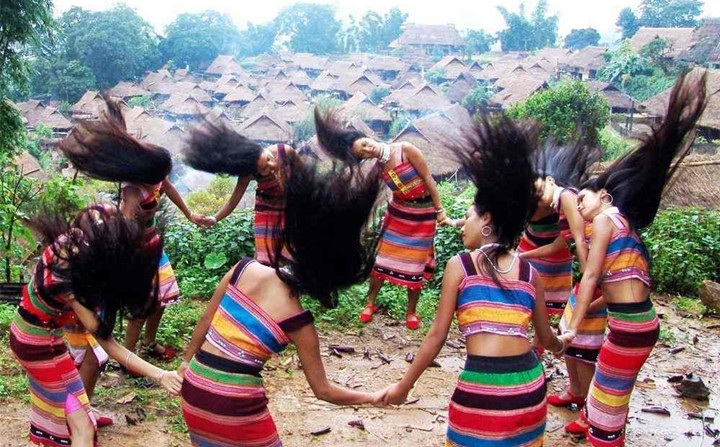

Cangyuan Cliff Paintings
The cliff paintings of Cangyuan is said to take on different colors as the time, weather and humidity change. According to the proverb of the local Wa and Thai(dǎi 傣) people that the cliff painting changes three times a day: in the morning the color is red, at noon lighter and in the evening purple. Nowadays the paintings have already been designated as the key historical relic protection unit at the provincial level.

Up to now, eleven painted cliffs have been found to scatter in several villages of Cangyuan County and Dima County etc. Called Randianmu (rǎn diǎn mǔ 染典姆) which means the paintings on the rocks in the local Wa language, these reddish brown ancient paintings were basically drawn on the grey limestone at the elevation of about 1, 500 meters. Measuring somewhere between one to thirty square meters, these primitive masterpieces are normally two to ten meters above the ground and include the images of animals, architectures, trees, boats, heavenly bodies like the sun or the moon, mountains and many abstract symbols etc. Human figures and lively life scene are also the important themes of these artistic works on the sharp cliffs. The eyes, nose and other facial details of the human face are normally omitted; the painters instead paid more attention to the depiction of the human body and limbs. Apart from artistic meanings and value, many important life activities of these human ancestors such as hunting, dancing, recreation and sacrifice rituals and suchlike are vividly displayed and recorded, which seems to bring the viewers back to those mysterious and remote prehistoric ages.
Tips: The tour of viewing the cliff painting is subject to the weather condition. Visitors who plan to see the painting should therefore consult the local travel agent about the timing of their visit in advance. Lincang is rich in rainfall and the rainy season comes from May until October.
DongJing Buddhist Temple
In the main hall of the DongJing Buddhist Temple (dòng jǐng fó sì 洞景佛寺), there are a gold statue of Sakyamuni and 22 statues of the Laughing Budda (Mile Buddha or Buddha of the future). This temple is particularly notable in southeastern Asian countries because it is home to the Buddha relic of Sakyamuni. According to the archeological record, after Sakyamuni passed away and was cremated, his bone, called “sarīra” in Sanskrit, was divided into eight shares, which were distributed across the region. The Buddha’s holy relic or sarīra was believed to bear the Buddha’s supreme power and thus be able to save all the lives on the earth. One of the eight shares was buried and worshiped in this temple. When the restoration of the temple was launched in 1994, 69 Buddha statues and a large quantity of jewelry, bronze statues and small pagodas were found in the site. Among the unearthed two pieces of bronze inscriptions mention the historical event of burying the Buddha’s holy bone here. One piece of 3 cm long transparent finger-like crystal is the holy bone, the discovery of which makes the temple more mysterious, holy and attractive to Buddhist followers from all over the world.
Location: Mengding Town, Gengma County.
Transportation: take regular bus from Gengma to Mengding.
Lincang Tea Culture and Customs Garden
As the home of Yunnan black tea, the area has the largest tea garden and the greatest tea output in Yunnan. Its has more than 5,500 mu ancient tea plants and has done for over 3,200 years.Lingcang Tea Culture and Customs Garden(lín cāng chá wén huà fēng qíng yuán 临沧茶文化风Cangyuan Cliff
You will only receive emails that you permitted upon submission and your email address will never be shared with any third parties without your express permission.
